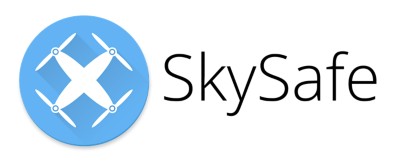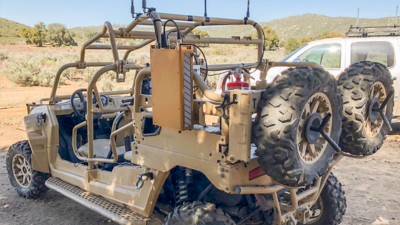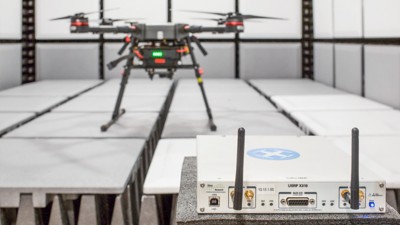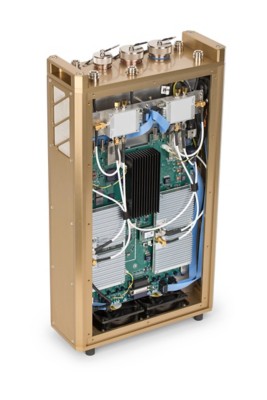SkySafe Defeats Commercial Drone Threats with Open-Source SDR
Scott Torborg, CTO, SkySafe

Case Study Highlights
- SkySafe delivered a drone defense solution faster and at a lower cost with NI SDR products.
- As new drone threats emerge, SkySafe can rapidly prototype and deploy new algorithms based on the NI SDR open source software toolchain.
- The low size weight and power (SWaP) of the USRP X310 SDR provided a highly mobile and deployable drone defense solution.

“The National Instruments Ettus Research USRP X310 is the only commercially available SDR with the openness and raw RF and DSP capabilities to meet the needs of this rapidly evolving drone threat.”
—Scott Torborg, CTO, SkySafe
The Challenge
With the emergence of highly capable, low-cost, wirelessly controlled drones, bad actors can easily execute disruptive operations, such as recent airport intrusions reported in European news outlets. Such incidents have created a need for drone defense systems that rapidly evolve with ever-increasing threat frequency and sophistication.
The Solution
SkySafe developed a cutting-edge software defined radio (SDR)-based capability on the open and flexible Ettus Research USRP X310 to counter the growing threat of low-cost drones. Being able to rapidly prototype and deploy with the NI USRP Software Defined Radio Device, SkySafe delivered industry-leading capability into the field faster and at a much lower cost to the government.
It’s nearly impossible to look at technology news without seeing an article about drones. Whether detailing how Amazon wants to use drones to deliver packages or revealing amazing aerial video of automated drones following Olympic snowboarders, commercial drones are becoming ubiquitous. Drone emergence has benefited many applications, including sports broadcasting and wildlife preservation wilderness surveys. Offering powerful intelligent software, drones are becoming less expensive and easier to use, with substantial operating range. As with any disruptive technology, drone operation often attracts bad actors looking to exploit the capability for less-than-noble objectives. Some reports have shown unmanned commercial drones being used for unwanted surveillance and even disrupting commercial airspace, as we recently saw in the United Kingdom.
Fortunately, many strive to counter these bad actors by developing drone defense systems. Most drone defense systems leverage technology to detect and defeat threats. These systems use both active and passive radar, and many leverage optical verification. Defeat methods vary, from nondestructive communication interception and GPS jamming, to using destructive countermeasures such as munitions or directed high-power lasers.
Key Drone Defense System Technology Challenges
Every year, newer, more intelligent commercial drones offer increasingly more sophisticated command and control (C2) and navigation systems. Today, it’s not uncommon for a drone to have active object avoidance and autonomous modes. When a drone isn’t under direct pilot control, it makes C2 countermeasures difficult; thus, it is common to disrupt or deny GPS with either spoofing or jamming. Drones with active remote piloting offer a variety of communication methods, ranging from basic analog modulation to highly secure digital links with encrypted commands. Traditionally, you might consider using a legacy high-power jamming technique; however, these can be quite disruptive to friendly forces and can compromise a stealth operation—not to mention dealing with regulatory obstacles in many countries. Making a single defense system adaptable to target the wide range of C2 disruption methods is a considerable challenge.
First, how do you keep pace with technological evolution and field new threat countermeasures quickly? Because traditional long Department of Defense (DoD) program development cycles may be incompatible, many systems have moved to commercial off-the-shelf technology for faster deployment so that system designers can focus on the threat instead of hardware implementation.
Second is the question of mobility: While base protection is important, many military operators need to deploy an effective countermeasure solution on vehicles in remote areas. Many times, they lack the luxury of a vehicle with the capacity to house a full-scale radar system that includes cameras and destructive countermeasures. Mobile systems must maintain stealth and a long operational life on mission; thus, it often comes down to SWaP. Choosing a platform that can go from prototype to deployment and meet SWaP and radio performance standards is important.

The SkySafe Drone Defense Solution
SkySafe is an innovative, US-based company with the mission to deliver world-class nondestructive drone defense and airspace control solutions. By applying advanced radio engineering and deep threat analysis, the company provides comprehensive airspace awareness and control solutions to military, public safety, and commercial customers. The SkySafe solution employs nondestructive countermeasures by disrupting the C2 and navigation systems of many common threats. Additionally, SkySafe software can intercept navigation downlink reports and passively display drone locations to an operator in real time. As regulatory space is evolving, SkySafe has focused on military drone defense applications and delivered solutions under DoD contract.

To combat both technology evolution and SWaP challenges, SkySafe built its system on NI commercial SDR technology. By combining NI SDR with open source software, SkySafe can rapidly adapt to evolving threats by simply deploying new algorithms, which reduces the time and cost to deploy new capabilities. Key to the SkySafe solution’s effectiveness is its proprietary innovative software radio algorithms.
The SkySafe drone defense system uses the NI brand Ettus Research USRP X310 SDR, the GNU Radio open source software community, and the RFNoC, a flexible FPGA framework. The USRP X310 is designed for adaptability, making it perfect for a rapidly developed, highly adaptable, low-power mobile application. According to Scott Torborg, SkySafe CTO, “The National Instruments Ettus Research USRP X310 is the only commercially available SDR with the openness and raw RF and DSP capabilities to meet the needs of this rapidly evolving drone threat.”
To solve for form factor and ruggedization, the SkySafe solution repackages the USRP X310 into a sturdy vehicle-mount enclosure (see Figure 2). Environmental protection and system hardening have been a part of the SkySafe design from the outset, and NI's support in adapting the USRP X310 was key to meeting SkySafe’s environmental requirements.

Conclusion
Drones are fun and useful technology; however, some seek to exploit this disruptive technology with bad intent. Defending against this new threat presents both technological and regulatory challenges. As regulations evolve, most drone defense development targets military applications. SkySafe has delivered a highly capable system built on NI SDR technology that has proven to meet both the pace of threat evolutions and form factor requirements with the USRP X310 and open source software.
